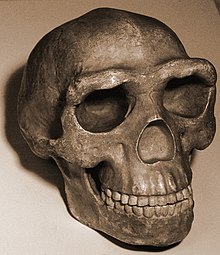
Back Pekingmens Afrikaans إنسان بيكينغ Arabic পেকিং মানৱ Assamese Homo erectus pekinensis AST Синантроп Bashkir Сінантрап Byelorussian Синантроп Bulgarian Home de Pequín Catalan Pekingský člověk Czech Homo erectus pekinensis Welsh
| Peking Man Temporal range: Middle Pleistocene
| |
|---|---|

| |
| Traditional reconstruction of the Peking Man skull | |
| Scientific classification | |
| Domain: | Eukaryota |
| Kingdom: | Animalia |
| Phylum: | Chordata |
| Class: | Mammalia |
| Order: | Primates |
| Suborder: | Haplorhini |
| Infraorder: | Simiiformes |
| Family: | Hominidae |
| Subfamily: | Homininae |
| Tribe: | Hominini |
| Genus: | Homo |
| Species: | |
| Subspecies: | †H. e. pekinensis
|
| Trinomial name | |
| †Homo erectus pekinensis | |
| Synonyms | |
|
Sinanthropus pekinensis | |
Peking Man (Homo erectus pekinensis) is a subspecies of H. erectus which inhabited the Zhoukoudian cave site in modern northern China during the Chibanian. The first fossil, a tooth, was discovered in 1921, and the Zhoukoudian Cave has since then become the most productive H. erectus site in the world. Peking Man was instrumental in the foundation of Chinese anthropology, and fostered an important dialogue between Western and Eastern science for decades to come. The fossils became the centre of anthropological discussion, and were classified as a direct human ancestor, propping up the Out of Asia hypothesis that humans evolved in Asia.
Peking Man also played a vital role in the restructuring of the Chinese identity following the Chinese Communist Revolution, and was intensively communicated to working class and peasant communities to introduce them to Marxism and science. Early models of Peking Man society strongly leaned towards communist or nationalist ideals, leading to discussions on primitive communism and polygenism. This produced a strong schism between Western and Eastern interpretations, especially as the West adopted the Out of Africa hypothesis by late 1967, and Peking Man's role in human evolution diminished as merely an offshoot of the human line. Though Out of Africa is now the consensus, Peking Man interbreeding with human ancestors is frequently discussed especially in Chinese circles.
Peking Man is characterised by a long and heavily fortified skull, featuring an inflated bar of bone circumscribing the crown, crossing along the brow ridge, over the ears, and connecting at the back of the skull, as well as a sagittal keel running across the midline. The bone of the skull and long bones is exorbitantly thickened. The face was protrusive (midfacial prognathism), eye sockets wide, jaws robust and chinless, and teeth large. Brain volume ranged from 850 to 1,225 cc, for an average of just over 1,000 cc (compared to an average of 1,270 cc for present-day modern males and 1,130 for present-day modern females). The limbs are broadly anatomically comparable to those of modern humans. H. erectus in such northerly latitudes may have averaged roughly 150 cm (4 ft 11 in) in height, compared to 160 cm (5 ft 3 in) for more tropical populations.
Peking Man lived in a cool, predominantly steppe, partially forested environment, alongside deer, rhinos, elephants, bison, buffalo, bears, wolves, big cats, and a menagerie of other creatures. Peking Man intermittently inhabited the Zhoukoudian Cave, but the exact chronology is unclear, with estimates as far back as 780,000 years ago and as recent as 230,000 years ago. This spans several cold glacial and warm interglacial periods. The cultural complexity of Peking Man is fiercely debated. If the inhabitants were capable of hunting (as opposed to predominantly scavenging), making clothes, and controlling fire, they would have been well-equipped to survive frigid glacial periods. If not, they would have had to retreat southward and return later. It is further disputed how the Peking Man fossils were predominantly deposited in the cave, either because they lived and died there, or they were killed by giant hyaenas (Pachycrocuta) and dumped there, in addition to other natural processes. Over 100,000 pieces of stone tools were recovered, mainly small and inconsistently shaped flakes no more than 5 cm (2.0 in) long, but they were sometimes refined into scrapers, choppers, and, towards the later end of occupation, points, burins, and awls.
© MMXXIII Rich X Search. We shall prevail. All rights reserved. Rich X Search